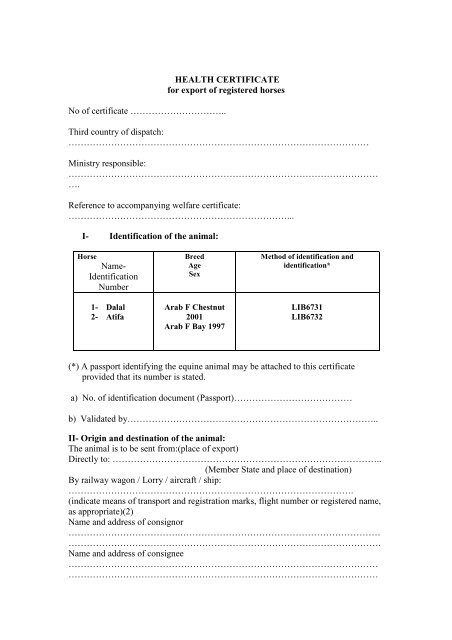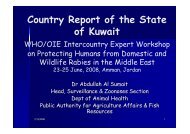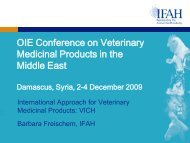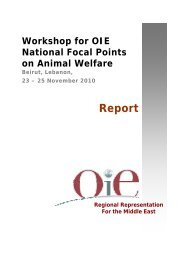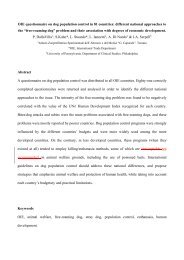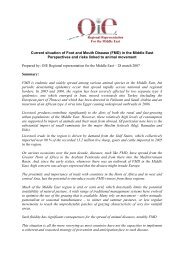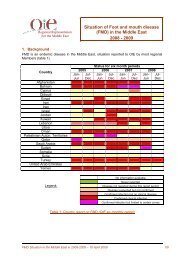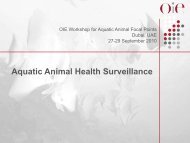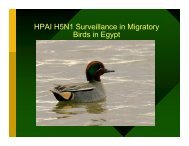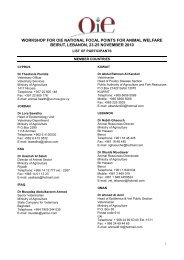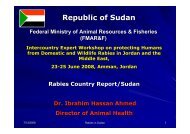HEALTH CERTIFICATE for export of registered horses ... - Middle East
HEALTH CERTIFICATE for export of registered horses ... - Middle East
HEALTH CERTIFICATE for export of registered horses ... - Middle East
- No tags were found...
You also want an ePaper? Increase the reach of your titles
YUMPU automatically turns print PDFs into web optimized ePapers that Google loves.
<strong>HEALTH</strong> <strong>CERTIFICATE</strong><strong>for</strong> <strong>export</strong> <strong>of</strong> <strong>registered</strong> <strong>horses</strong>No <strong>of</strong> certificate …………………………..Third country <strong>of</strong> dispatch:………………………………………………………………………………………Ministry responsible:…………………………………………………………………………………………….Reference to accompanying welfare certificate:………………………………………………………………...I- Identification <strong>of</strong> the animal:HorseName-IdentificationNumber1- Dalal2- AtifaBreedAgeSexArab F Chestnut2001Arab F Bay 1997Method <strong>of</strong> identification andidentification*LIB6731LIB6732(*) A passport identifying the equine animal may be attached to this certificateprovided that its number is stated.a) No. <strong>of</strong> identification document (Passport)…………………………………b) Validated by………………………………………………………………………..II- Origin and destination <strong>of</strong> the animal:The animal is to be sent from:(place <strong>of</strong> <strong>export</strong>)Directly to: ……………………………………………………………………………..(Member State and place <strong>of</strong> destination)By railway wagon / Lorry / aircraft / ship:………………………………………………………………………………….(indicate means <strong>of</strong> transport and registration marks, flight number or <strong>registered</strong> name,as appropriate)(2)Name and address <strong>of</strong> consignor……………………………….…………………………………………………………………………………………………………………………………………………….Name and address <strong>of</strong> consignee……………………………………………………………………………………………………………………………………………………………………………………
Or(3) the animal was vaccinated on ……………..(4) against equineviral arthritis under <strong>of</strong>ficial veterinary supervision with a vaccineapproved by the competent authority, according to the followingprogramme <strong>for</strong> initial vaccination and has been re-vaccinated atregular interval(3)(4);Programmes <strong>for</strong> initial vaccination against equine viral arthritis:Instruction: Cross out vaccination programmes that do not apply to theanimal described above.a) vaccination was carried out on the day a blood sample was takenthat subsequently proved negative in a virus neutralization test at adilution <strong>of</strong> 1 in 4(5); orb) vaccination was carried out during a period <strong>of</strong> isolation <strong>of</strong> not morethan 15 days under <strong>of</strong>ficial veterinary supervision, commencing onthe day a blood sample was taken that was tested during that timewith a negative result in a virus neutralization test at a dilution <strong>of</strong> 1in 4(5); orc) vaccination was carried out when the animal was at an age <strong>of</strong> 180to 270 days, during a period <strong>of</strong> isolation under <strong>of</strong>ficial veterinarysupervision, during the isolation period two blood samples taken atleast 10 days apart proved a stable or declining antibody titre in avirus neutralization test <strong>for</strong> equine viral arthritis;f) It does not come from the territory or from a part pf the territory <strong>of</strong> athird country considered, in accordance with EEC legislation, as infectedwith African horse sickness.- either it was not vaccinated against African horse sickness(3); or- it was vaccinated against African horse sickness on ……………………...g) It does not come from a holding which was subject to prohibition <strong>for</strong>animal health reasons nor had contact with equidae from a holding whichwas subject to prohibition <strong>for</strong> animal health reasons;i) during six months in the case <strong>of</strong> equine encephalomyelitis, beginning onthe date on which the equidae suffering from the disease are slaughtered;ii) in the case <strong>of</strong> infectious anaemia, until the date on which the infectedanimals having been slaughtered, the remaining animals have shown anegative reaction to two Coggins tests carried out three months apart;iii) during six months in the case <strong>of</strong> vesicular stomatitis;iv) during one month from the last recorded case, in the case <strong>of</strong> rabies;v) during 15 days from the last recorded case, in the case <strong>of</strong> anthrax.If all animals <strong>of</strong> species susceptible to the disease located on the holdinghave been slaughtered and the premises disinfected, the period <strong>of</strong>prohibition shall be 30 days, beginning on the day on which the animalswere destroyed and the premises disinfected, except in the case <strong>of</strong> anthrax,where the period <strong>of</strong> prohibition is 15 days;h) It shows no clinical signs <strong>of</strong> contagious equine metritis (CEM) and it doesnot come from a holding where there has been any suspicion <strong>of</strong> CEMduring the past two months nor had contact indirectly or directly throughcoitus with equidae infected or suspected <strong>of</strong> CEM;
i) To the best <strong>of</strong> my knowledge, it has not been in contact with equidaesuffering from an infectious or contagious disease in the 15 days prior tothis declaration;j) It was subjected to the following blood tests;- a Coggins test <strong>for</strong> infectious anaemia on ………………(4), this beingwithin 30 days <strong>of</strong> <strong>export</strong>, with negative result (4)(5).- a complement fixation test <strong>for</strong> dourine on ……………….(4), this beingwithin 21 days <strong>of</strong> <strong>export</strong>, with negative result at a dilution <strong>of</strong> 1 in 10(4)(5);- a complement fixation test <strong>for</strong> glanders on ……………..(4), this beingwithin 21 days <strong>of</strong> <strong>export</strong>, with negative result at a dilution <strong>of</strong> 1 in 10(4)(5);- a test <strong>for</strong> African horse sickness carried out on a sample <strong>of</strong> blood takenwithin 10 days <strong>of</strong> <strong>export</strong> on …………………….. with negative reaction.IV- the animal will be sent in a vehicle cleansed and disinfected in advance with adisinfectant <strong>of</strong>ficially recognised in the country <strong>of</strong> dispatch and designed in a way thatdroppings, litter or folder cannot escape during transportation.The following declaration signed by the owner or representative is part <strong>of</strong> thecertificate.V- The certificate is valid <strong>for</strong> 10 days. In the case <strong>of</strong> transport by ship the time isprolonged by the time <strong>of</strong> the voyage.Date Place Stamp(*) and signature <strong>of</strong> the <strong>of</strong>ficialveterinarian………………………………………………………………………………………………………………………………………………………………(name in block letters, qualification ad title)(*) The colour <strong>of</strong> the stamp must be different to that <strong>of</strong> the printing,DECLARATIONI, the undersigned …………………………………………………………….., (insertname in block letters) declare:(owner or representative <strong>of</strong> the animal described above)1- The animal will be sent directly from the premises <strong>of</strong> dispatch to the premises<strong>of</strong> destination without coming into contact with other equidae not <strong>of</strong> the samehealth status.The transportation will be effected in such a way that health and well-being <strong>of</strong>the animal can be protected effectively;2- The animal has either remained in …………………………………….(<strong>export</strong>ing country) since birth(1) or has been imported directly from a
Member State <strong>of</strong> the European Community during the past 90 days (1) orentered the <strong>export</strong>ing country at least 90 days prior to this declaration(3),…………………………………………..…………………………………………(Place, date)(Signature)


